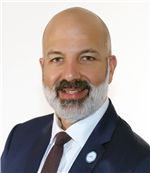The 1619 Project
 Dear colleagues,
Dear colleagues,
Welcome back from the much-needed winter break. To those of you who worked during break, I hope you got to enjoy a couple long weekends and some quality time with loved ones.
Two summers ago, I recall getting an email from one of the several listservs I belong to. It was from The New York Times, and it was the much-anticipated release of The 1619 Project. Nikole Hannah-Jones is the creator of The 1619 Project, and I have followed her work for quite some time. If you read the previews, viewed the picture stories, listened to the podcast, accessed the curriculum or finally received a copy of the book, you can appreciate the rich history told by the project’s many contributing historians.
The release of The 1619 Project coincided with the 400th anniversary of the arrival of enslaved people to America. Hannah-Jones was determined not to celebrate these facts like many festive anniversaries do; her aim was to have the truth told and shared.
Diving into The 1619 Project is an individual journey. All of us had different experiences growing up and learning about the United States and its abominable history of slavery. My curiosity led me to form a critical eye for how this project was being revealed, and I paid particular attention to the divided acclaim this historic work was receiving.
While many in the mainstream media were quick to celebrate this monumental anthology, there were others who immediately aimed to subvert it. Today, The 1619 Project remains a source of controversy. Hannah-Jones has endured public scrutiny that is to be expected when a Black journalist/author uses their platform. But the opposition to The 1619 Project and other books, authors and leaders that have spoken out during this time of racial reckoning has matched and even eclipsed the resistance to other movements in our nation’s history.
This counter movement has pulled another term out from the depths of history and inserted, highlighted and shouted it from the largest stages. Critical Race Theory, or CRT, is being hurled like kryptonite to weaken and diminish the important stories, narratives and facts presented by Hannah-Jones and many others.
When I learn about the system that was assembled in 1619 and strategically and covertly developed over the past 400 years, the comparisons to our society today are nearly indistinguishable.
From the book: “During the height of racial terror in this country, Black Americans were not merely killed in mob attacks and lynchings but castrated, burned alive, and dismembered, with body parts displayed in storefronts and strewn across lawns in Black communities. This violence was meant to terrify and control Black people, but perhaps just as importantly, it served as a psychological balm for white supremacy: you would not treat human beings this way. The extremity of the violence was a symptom of the psychological mechanism necessary to absolve white Americans of their country’s original sin….white Americans resorted to the same racist ideology that Jefferson and the framers had used at the nation’s founding: that Black people were an inferior race whose degraded status justified their treatment.”
An important addition to this excerpt is the suppression of education from enslaved Blacks. Specifically, literacy was largely viewed as a skill that would undo the bondages of enslavement. Today, I celebrate passing a new graduation requirement for all SPPS students to take Critical Ethnic Studies. It is my expectation that this course will acknowledge and build on the histories of all of our students, families and staff. I am also acutely aware that student outcomes in nearly every category are predictable, and in many ways resemble the histories of the African Americans depicted in The 1619 Project.
By challenging our assumptions and what we believe to be true, our knowledge can be expanded, and our actions aligned in equity. Listening to new perspectives or those that have challenged me in the past allows me to build critical skills in navigating the dynamics of difference (from The Culturally Proficient School) and learning more about them. Identifying inequities and removing barriers is a cornerstone of equity work. Understanding how and why systems were created is essential knowledge that can be used to unlock how we serve our communities. It does not diminish the need for high expectations or rules, but when high expectations and rules benefit some and not all, we must question the system.
The work of Hannah-Jones and others continually challenges me as an equity leader in a system assembled more than 400 years ago that continues to uphold the vestiges that it was intended to. Words in a strategic plan, a professional development session or a book study are not enough and only scratch the surface. Citing The 1619 Project is also not enough. That said, I will not stand for far-reaching opposition seeking to restrain painful but critical understanding of the historical trauma inflicted on the young people, women and men that were brought to this country as slaves or born into a life of oppression.
Please join me and pledge to take a stand in identifying racial inequities and committing to solutions that remove barriers and create communities of learning where all are valued and supported.
In partnership,

Joe Gothard, Superintendent




